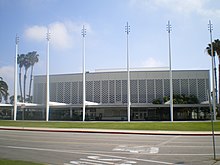Welton Becket

Welton Becket (August 8, 1902-January 16, 1969) was an architect who designed many of the most famous buildings in Hollywood and Los Angeles, California. he also designed the Jai Alai building in Manila, Philippines. He was born in Seattle, Washington. He graduated from the University of Washington program in Architecture in 1927 with a Bachelor of Architecture degree (B.Arch.).
Becket's extensive list of credits includes the Theme Building at LAX, The Capitol Tower, the Cinerama Dome, PNC Plaza in Louisville, Kentucky, Disney's Contemporary Resort, the Los Angeles Music Center (including the Dorothy Chandler Pavilion), the master plan for Century City, the Beverly Hilton, and the Santa Monica Civic Auditorium. Also the General Petroleum Building - 1949 (now The Pegasus apartment complex)
Becket settled in Los Angeles in 1933 and formed a partnership with his University of Washington classmate Walter Wurdeman and Angelean architect Charles F. Plummer. Their first major commission was the landmark Moderne Pan-Pacific Auditorium in 1935, which won them residential jobs from James Cagney, Robert Montgomery, and other film celebrities. Plummer died in 1939.
The successor firm Wurdeman and Becket went on to design Bullock's Pasadena (1944) and a couple of corporate headquarters. Wurdeman and Becket developed the concept of 'total design', meaning that their firm should be responsible for master planning, engineering, interiors, furniture, fixtures, landscaping, signage, down to menus, silverware, matchbooks, and napkins.

After Wurdeman's untimely death in 1949, Becket formed Welton Becket Associates and continued to relentlessly grow the firm. Most active in the 1950's and 60's, Becket's architectural work is characterized by a straightforward, 'businesslike' design approach that prioritized his clients' requirements over developing a recognizable signature style for himself. Recenty the work of his firm has been cited as an important 'mid-Century modern' reference point. Reportedly he told one interviewer, "I see no reason to express Welton Becket." At the time of Becket's death in 1969, his architectural firm was the largest in the world. In 1987, his firm was acquired by Ellerbe Associates, and the merged firm continues in operation today as Ellerbe Becket.
Despite Becket's attempts to distance himself from creating a personal signature style of architecture, his buildings are often easily recognized by their use of unusual facade materials such as ceramic tile and stainless steel grillwork, repetitive geometric patterns, and a heavy emphasis on walls clad in natural stone, particularly travertine and flagstone.
With The Walt Disney Company and the United States Steel Corporation, Becket's firm co-designed Disney's Contemporary Resort, which opened in 1971 at Walt Disney World Resort. The Contemporary was designed as a 14-story steel A-frame with a monorail running through it. Modular guest rooms were assembled, finished, furnished, fully equipped down to Gideon Bibles and toilet paper, and their doors locked, on the ground, then lifted by crane and inserted (video below) into the frame like a dresser drawer. This was to give Disney the ability to rapidly 'un-plug' and re-furnish rooms at will. Unfortunately the steel frame settled and trapped the original rooms into their original positions.
Welton Becket was elected a Fellow of the American Institute of Architects in 1952.
Welton's sons, Welton Becket II & Bruce Becket, are also practicing architects. Welton senior's grand daughter Cayce Becket & her husband Gregory Horgan follow in the family footsteps.

External links

